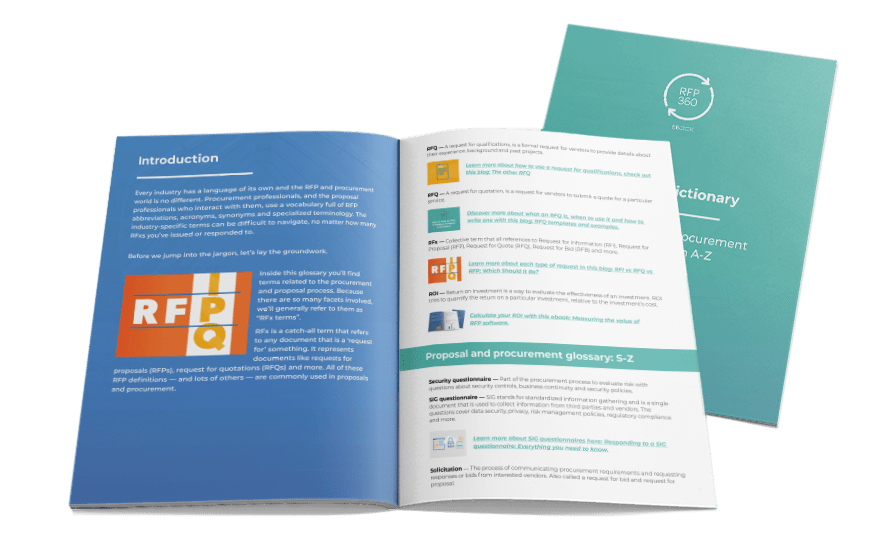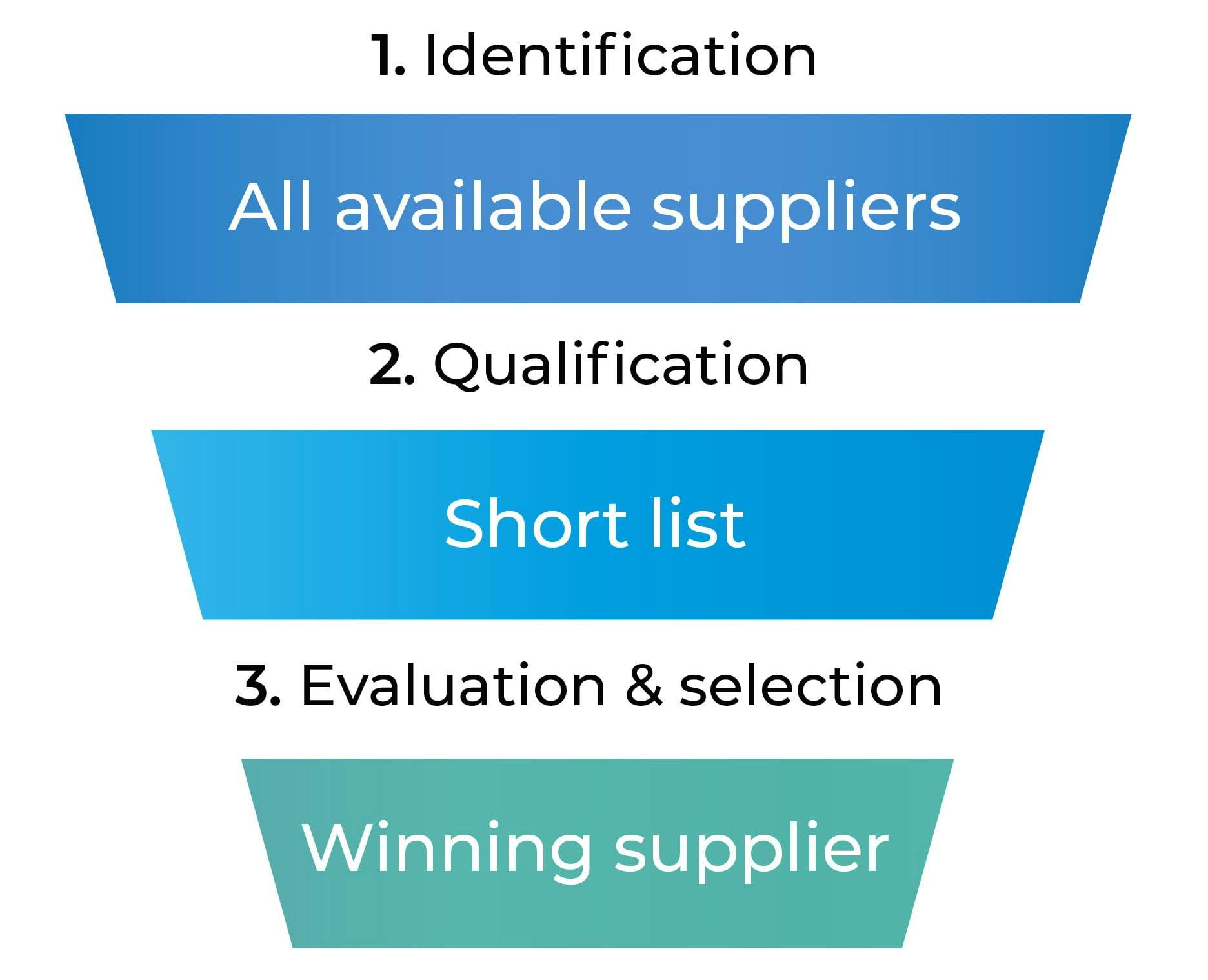When it comes to protecting your business from risk and enabling growth, supplier selection is one of the most important responsibilities of the procurement department. Indeed, the suppliers and vendors your business partners with are directly linked to the success or failure of your business.
In the current landscape, technology removes barriers and makes finding and connecting with new suppliers easier than ever. As a result, there are dozens, if not hundreds, of possible suppliers for nearly every business need.
The supplier selection process enables procurement professionals to discover, qualify, evaluate and select potential partners. In this blog, I’ll define supplier selection, clarify the use of supplier vs. vendor and offer an example of why supplier selection is so important. Then, I’ll walk through each of the steps of the supplier selection process.
What is supplier selection?
Supplier selection is how businesses determine which vendors to partner with to provide necessary goods and services. The process includes finding suppliers, ensuring they are qualified, evaluating them and selecting which are the best fit for the business’s needs.
The Procedia Manufacturing Journal defines supplier selection this way:
“Supplier selection is the process by which firms identify, evaluate, and contract with suppliers. The supplier selection process deploys an enormous amount of a firm’s financial resources and plays a crucial role for the success of any organization. The main objective of the supplier selection process is to reduce purchase risk, maximize overall value to the purchaser, and develop closeness and long-term relationships between buyers and suppliers.”
The procurement department handles supplier selection and supplier relationship management (SRM) as part of the larger practice of vendor management.
Key terminology: Supplier vs vendor
One question that frequently comes up in procurement is the difference between a supplier and a vendor. Often, the terms are used interchangeably and any distinction between the two will depend on who you ask.
Indeed, the use of supplier vs. vendor varies from one industry to another and even from one business to the next. For the most part, in my day-to-day work, I hear both terms used identically to refer to any entity that is contracted to provide goods or services.
For those who do differentiate between the two terms, generally speaking, a supplier provides materials in a business-to-business (B2B) relationship. Those materials are then used to create a product. Alternatively, a vendor may buy that product from the supplier and sell it in a business-to-business or business-to-consumer (B2C) capacity.
For more procurement and RFP definitions, download the RFP glossary.

The importance of successful supplier selection
Choosing the right supplier to partner with provides ongoing benefits and enables your business to meet their goals and grow. On the other hand, selecting the wrong supplier may have far-reaching consequences.
For example, in 2008, during the manufacturing of their 787 Dreamliner, Boeing discovered a problem with some of their fasteners. Unfortunately, the supplier of the fasteners experienced a shortage and wasn’t able to deliver the required component quickly.
With more than 900 orders to fill, Boeing ended up delaying delivery to customers at least six times over a period of two years. Subsequently, many customers cancelled or deferred their orders. While countless factors contributed to the problem, the end result was disastrous for the company. Unsurprisingly, Boeing’s bottomline suffered. That year, they reported a loss of $85 million. The debacle received significant media coverage, became the subject of procurement case studies and still serves as a supplier selection cautionary tale.
The supplier selection process
With the importance of supplier selection in mind, it should come as no surprise that procurement managers take finding, evaluating and contracting with suppliers very seriously. The supplier selection process creates an organized framework to minimize partner risk while maximizing value provided to the business.
Think of the supplier selection process as a funnel. In theory, at the beginning of the process, every available supplier is potentially an option. Then, as you learn more about each supplier and qualify them, the group narrows down to a short list. Next, the business evaluates the short-listed suppliers against the requirements and priorities of the project. Until finally, the business selects a supplier and awards the business.

1. Identification: Finding all available suppliers
The first step of the supplier selection process is identifying potential suppliers. This may seem obvious, but it’s harder than you might think. For example, if you need to find a new employee benefits provider, where do you start? Your first instinct may be to reach out to the big name providers. However, to be successful, businesses must not only engage with known suppliers, but constantly seek out new options. After all, to pick the perfect vendor, you have to know they exist and include them in your process.
Where to find potential suppliers
- Peer recommendations — Connect with your professional network and ask for supplier recommendations. You’ll hear candid feedback and honest performance reviews.
- Industry directories and associations — Look for trade publications and associations that publish supplier directories and reviews.
- Procurement consultants — For specialty procurement projects, you may consider engaging an RFP consultant who can find and evaluate suppliers to meet a specific need.
2. Qualification: Selecting your shortlist
Next, it’s time to narrow it down. Filter your list of all available suppliers to only the most qualified. If you use a traditional RFP process, aim for a short list of less than 10 suppliers. Alternatively, if you want to include more suppliers in the evaluation step, consider using an RFP lite.
Ultimately, the goal of creating a short list is to make the next step, evaluation, easier. Keep in mind that the total number of data points you’ll need to review is determined by multiplying the number of RFP questions by the number of suppliers that respond to your RFP.
If you leverage RFP management software that automates the evaluation process, adding 10 more questions and three more vendors may not extend your RFP timeline significantly. However, if you review and score responses manually, too many questions and sent to too many vendors causes major delays.
Establish supplier selection criteria
The best way to narrow the supplier field is to define your supplier selection criteria. Start by collaborating with stakeholders to define goals and priorities. Create a list of factors that are most important to your company. Use these deal-breaker considerations to refine your supplier list.
Sample supplier selection criteria
- Is it important to work with a local, regional, national or international business?
- Does your business prefer to work with an established company or a newer, potentially more innovative option?
- What company policies must the supplier adhere to? Consider diversity, sustainability and other social initiatives that influence supplier selection.
Not only is this exercise useful for creating a shortlist, but it is also helpful to refer back to these priorities when making your final selection in the next step.
Use an RFI, RFQ or vendor profiles to select your short list
In addition to establishing supplier selection criteria, consider using a request for information (RFI), request for qualifications (RFQ) or vendor profiles to qualify suppliers for your short list.
Request for information
The RFI process collects general information from suppliers about the solutions they provide. The question and answer format makes vendor comparison easier.
Discover more about how RFIs improve your supplier selection process here.
Request for qualifications
If expertise and quality are your highest priority, an RFQ is a good option. The document asks potential suppliers to detail their background and experience.
Learn more about the request for qualifications and see an example in this blog.
Vendor profiles
For routine procurement it is useful to create vendor profiles as a way to catalog available options and manage vendor onboarding.
Explore how vendor profiles improve your strategic sourcing process and download a template here.
3. Evaluation: Selecting the winning supplier
Now comes the most important part — picking the winner. As the Info Entrepreneur says:
“Choosing the right supplier involves much more than scanning a series of price lists. Your choice will depend on a wide range of factors such as value for money, quality, reliability and service. How you weigh up the importance of these different factors will be based on your business’ priorities and strategy.”
With so many factors to weigh, the pressure of selecting the right supplier is overwhelming. Luckily, the request for proposal (RFP) process enables procurement teams to methodically evaluate each finalist side by side. In addition, RFPs include questions about security, finances and policy to manage risk.
The RFP process
1. Gather RFP requirements
First, reengage your stakeholders to establish priorities, requirements and scope. In addition, it is helpful to refer back to your initial supplier selection criteria.
2. Craft your RFP
If possible, start from an RFP template with an established format and standard questions to save time. Remember, provide background and context to help suppliers focus on what is most important to your business.
3. Conduct the evaluation
Once you’ve received proposals from your suppliers, it’s time to compare them. Prioritize the most important questions and sections of your proposal using weighted scoring. In addition, have stakeholders and subject matter experts score the sections that align with their field.
4. Make your final selection
Ideally, after everyone has weighed in on each proposal, a clear winner will emerge. If not, consider requesting additional information or scheduling RFP presentations.
5. Create and complete the contract
The last step in the supplier selection process is to negotiate terms, finalize the relationship and complete the contract.
Connecting your business with the right suppliers keeps operations running smoothly and enables growth. However, even with an established process, managing supplier selection manually is difficult. Unfortunately, there’s little room for error. Due to the complexity of supplier selection, many procurement teams leverage RFP software to simplify and centralize the process.
To explore the how an RFP management tool can improve your procurement team’s efficiency and effectiveness, download the ebook: Measuring the value of RFP software.
